Search results for: 'Egyptian ancient'
-
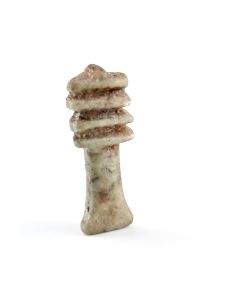 Djed-Pfeiler als Amulett
Djed-Pfeiler als AmulettÄgyptische Spätzeit, 26. bis 30. Dynastie. Mintgrüne Fayence. Der Djed-Pfeiler steht für Dauer und Beständigkeit und war im Alten Ägypten als Amulett sehr beliebt.
Price: on request Egyptian funerary cone of Amunemopet
Egyptian funerary cone of AmunemopetConoid clay nail from the tomb of crown prince Amunemopet. From Thebes during the 18th dynasty. New Kingdom of ancient Egypt.
Price: on request Central part of a mummy cartonnage
Central part of a mummy cartonnagePolychrome painted panel depicting the four sons of Horus and a representation of Kheper-Ra. The collar is resembling the falcon wing of Horus.
Price: on request Shabti for Ly-hotep-em-mut
Shabti for Ly-hotep-em-mutStunning Egyptian funerary figurine from the time of the 22nd dynasty. Formerly in the Rolls-Royce family collection.
Price: on request Ägyptisches Amulett der Isis
Ägyptisches Amulett der IsisAmulett aus Fayence mit Darstellung der Isis. Die Göttin trägt ein Gewand und eine dreigeteilte Perrücke, auf dem Kopf den Thronsitz. Spätzeit des Alten Ägyptens.
Price: on request Egyptian figure of an ibis
Egyptian figure of an ibisA nice bronze bird from the Late Period of Ancient Egypt. The ibis was the sacred bird of Thoth, god of wisdom and the sciences.
Price: on request Egyptian wooden statuette
Egyptian wooden statuetteFigure painted in black and red from the 12th dynasty of ancient Egypt. Probably part of a larger wooden model for a tomb.
Price: on request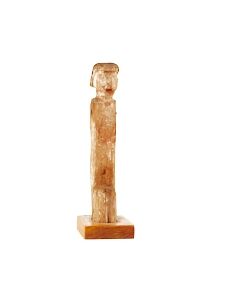 Egyptian wooden statuette
Egyptian wooden statuetteFigure painted in black and red from the 12th dynasty of ancient Egypt. Probably part of a larger wooden model for a tomb.
Price: on request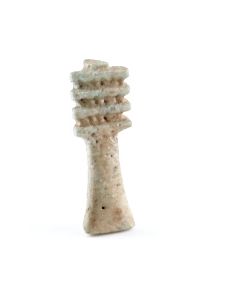 Djed pillar amulet
Djed pillar amuletÄgyptische Spätzeit, 26. bis 30. Dynastie. Mintgrüne Fayence. Der Djed-Pfeiler steht für Dauer und Beständigkeit und war im Alten Ägypten als Amulett sehr beliebt.
Price: on request Djed pillar amulet
Djed pillar amuletÄgyptische Spätzeit, 26. bis 30. Dynastie. Mintgrüne Fayence. Der Djed-Pfeiler steht für Dauer und Beständigkeit und war im Alten Ägypten als Amulett sehr beliebt.
Price: on request Djed pillar amulet
Djed pillar amuletÄgyptische Spätzeit, 26. bis 30. Dynastie. Mintgrüne Fayence. Der Djed-Pfeiler steht für Dauer und Beständigkeit und war im Alten Ägypten als Amulett sehr beliebt.
Price: on request Djed-Pfeiler als Amulett
Djed-Pfeiler als AmulettÄgyptische Spätzeit, 26. bis 30. Dynastie. Mintgrüne Fayence. Der Djed-Pfeiler steht für Dauer und Beständigkeit und war im Alten Ägypten als Amulett sehr beliebt.
Price: on request Egyptian faience ring showing Bes and Taweret
Egyptian faience ring showing Bes and TaweretThe finger ring with its scene on the plate must have served a protective function for an expectant mother. New Kingdom, approx. 1550 to 1070 BC.
Price: on request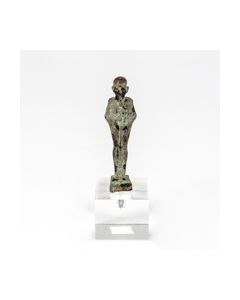 Egyptian bronze figurine of Ptah
Egyptian bronze figurine of PtahRare example of the not so widespread worship of Ptah. Bronze cast from the Late Period of ancient Egypt.
Price: on request Egyptian plaque of Bes
Egyptian plaque of BesRare type of depiction of the dwarf god. From the collection of the Newark Museum of Art. Late Period of Ancient Egypt. Including thermoluminescence analysis.
Price: on request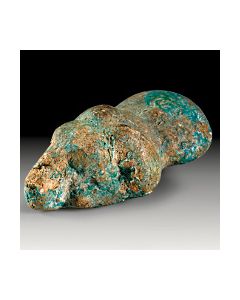 Egyptian amulet with ram head and sun disc
Egyptian amulet with ram head and sun discThe rare depiction is typical of the god Khnum. From the Late Period to Ptolemaic period of Ancient Egypt.
Price: on request Egyptian faience statuette of Taweret
Egyptian faience statuette of TaweretSimplistic depiction of the protective goddess for pregnant women. It can be worn as an amulet. A piece from the Late Period of Ancient Egypt.
Price: on request Ushabti des Nes-ta-hi
Ushabti des Nes-ta-hiÄgyptische Statuette, rund 80mm hoch, 22. Dynastie. Ausgeprägte Gesichtszüge, schöne blau-grüne Fayence. Hieroglyphen in etwa Osiris, Nes-ta-hi, maa-kheru.
Price: on request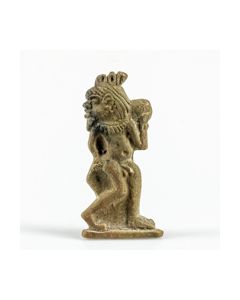 Egyptian plaque of Bes
Egyptian plaque of BesRare type of depiction of the dwarf god. From the collection of the Newark Museum of Art. Late Period of Ancient Egypt.
€1,780 Egyptian mummy mask from Hawara
Egyptian mummy mask from HawaraGilt cartonnage with polychrome painting in fantastic condition. A museum-worthy mummy mask from the late Ptolemaic period of Egypt, from the ancient necropolis of Hawara, at the entrance to the Fayyum Basin.
€53,000 Egyptian predynastic cosmetic palette
Egyptian predynastic cosmetic paletteHigh quality palette with two stylized bird heads. Characteristic for the Naqada II period. Circa 3500 to 3200 BC.
Price: on request Fayenceziegel vom Typ der Djoser-Pyramide
Fayenceziegel vom Typ der Djoser-PyramideÄgyptischer Ziegel aus dem Alten Reich, 2. bis 3. Dynastie, intensiv-türkisfarbene Fayence. Ziegelform bekannt aus der berühmten Stufenpyramide von Djoser.
Price: on request Faience tile of the Djoser pyramid type
Faience tile of the Djoser pyramid typeEgyptian wall tile from the Old Kingdom, 2nd to 3rd dynasty. The tile type is known from the famous step pyramid of king Djoser.
Price: on request Golden fingerring in the shape of a snake
Golden fingerring in the shape of a snakeBeautiful gold ring from Egypt in Roman Imperial times. Published in the exhibition catalogue of the Basel Museum of Ancient Art.
Price: on request Golden fingerring in the shape of a snake
Golden fingerring in the shape of a snakeBeautiful gold ring from Egypt in Roman Imperial times. Published in the exhibition catalogue of the Basel Museum of Ancient Art.
Price: on request Egyptian bronze statuette of Amun
Egyptian bronze statuette of AmunIt impresses by its size and artistic quality. An inscription identifies the piece as votive offering at one of Amun's temples. From the Late Period of Ancient Egypt.
€17,000 Egyptian protective amulet and seal with Pataikos
Egyptian protective amulet and seal with PataikosDwarf god with knifes in his hands and Eye of Horus on his belly. The bottom side is made as a stamp seal with hieroglyphic inscription. Work of highest quality with fine details. Dating to the Third Intermediate Period.
Price: on request Ägyptischer Ushebti mit T-förmiger Inschrift
Ägyptischer Ushebti mit T-förmiger InschriftTotenfigur aus mintfarbener Fayence mit hieroglyphischer Inschrift, 28. bis 30. Dynastie, Spätzeit. 105mm hoch.
Price: on request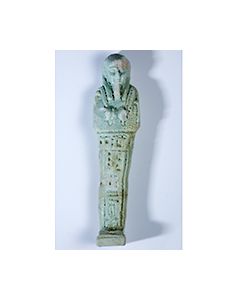 Ushebti des Ptahhotep
Ushebti des PtahhotepÄgyptische Statuette in musealer Erhaltung. 400 bis 332 v.Chr., Spätzeit, 28. bis 30. Dynastie. 10,5cm hoch. Mit Hieroglyphentext: Der erleuchtete Osiris, Herr der Kraft, Gottes Diener, Ptahhotep, ...
Price: on request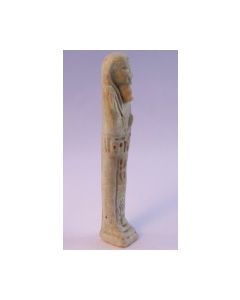 Uschebti des Ptahhotep
Uschebti des PtahhotepÄgyptische Statuette in musealer Erhaltung. 400 bis 332 v.Chr., Spätzeit, 28. bis 30. Dynastie. 10cm hoch. Mit Hieroglyphentext: Der erleuchtete Osiris, Herr der Kraft, Gottes Diener, Ptahhotep, ...
Price: on request Limestone figure of a concubine
Limestone figure of a concubineFigure of a woman on a support, her arms and hands close to her sides. Originating from ancient Egypt.
€1,850 Egyptian ushabti for Ra-mes
Egyptian ushabti for Ra-mesThe mummiform funerary figurine dates to the Late Period of ancient Egypt, 26th to 31st dynasty. It is remarkable that it probably originates from the burial of two brothers, Ra-mes and Somtus-tefnacht.
Price: on request Ushabti for Ra-mes
Ushabti for Ra-mesThe mummiform funerary figurine dates to the Late Period of ancient Egypt, 26th to 31st dynasty. It is remarkable that it probably originates from the burial of two brothers, Ra-mes and Somtus-tefnacht.
Price: on request Egyptian ushabti for Somtus-tefnacht
Egyptian ushabti for Somtus-tefnachtThe mummiform funerary figurine dates to the Late Period of ancient Egypt, 26th to 31st dynasty. It is remarkable that it probably originates from the burial of two brothers, Somtus-tefnacht and Somtus-tefnacht.
Price: on request Egyptian ushabti for Somtus-tefnacht
Egyptian ushabti for Somtus-tefnachtThe mummiform funerary figurine dates to the Late Period of ancient Egypt, 26th to 31st dynasty. It is remarkable that it probably originates from the burial of two brothers, Somtus-tefnacht and Somtus-tefnacht.
Price: on request Egyptian ushabti for Somtus-tefnacht
Egyptian ushabti for Somtus-tefnachtThe mummiform funerary figurine dates to the Late Period of ancient Egypt, 26th to 31st dynasty. It is remarkable that it probably originates from the burial of two brothers, Somtus-tefnacht and Somtus-tefnacht.
Price: on request

